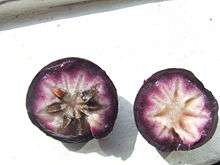Chrysophyllum cainito
| Chrysophyllum cainito | |
|---|---|
 | |
| Chrysophyllum cainito fruit | |
| Scientific classification | |
| Kingdom: | Plantae |
| (unranked): | Angiosperms |
| (unranked): | Eudicots |
| (unranked): | Asterids |
| Order: | Ericales |
| Family: | Sapotaceae |
| Genus: | Chrysophyllum |
| Species: | C. cainito |
| Binomial name | |
| Chrysophyllum cainito L. | |
Chrysophyllum cainito is a tropical tree of the family Sapotaceae. It is native to the Greater Antilles and the West Indies. It has spread to the lowlands of Central America and is now is grown throughout the tropics, including Southeast Asia.[1] It grows rapidly and reaches 20 m in height.
Overview
It has numerous common names including cainito, caimito, star apple, golden leaf tree, abiaba, pomme de lait, estrella, milk fruit and aguay. It is also known by the synonym Achras cainito. In Vietnam, it is called vú sữa (literally: milky breast/nipples). In Malayalam it is called "Swarnapathry" meaning '[the tree with] golden leaves'. In Cambodia, this fruit is called " plae teuk dos ko" which means milk fruit due to its milky juices inside.
The leaves are evergreen, alternate, simple oval, entire, 5–15 cm long; the underside shines with a golden color when seen from a distance. The tiny flowers are purplish white and have a sweet fragrant smell. The tree is also hermaphroditic (self-fertile). It produces a strong odor.
Fruits

The fruit is globose and typically measures from 2 to 3 inches in diameter.[2] When ripe, it usually purple-skinned with a faint green area appearing around the calyx. A radiating star pattern is visible in the pulp. Greenish-white and yellow-fruited cultivars are sometimes available. The skin is rich in latex, and both it and the rind are not edible. The flattened seeds are light brown and hard. It is a seasonal fruit bearing tree.
The fruits are delicious as a fresh dessert fruit; it is sweet and best served chilled. Infusions of the leaves have been used against diabetes and articular rheumatism. The fruit has anti-oxidant properties.,[3][4] The bark is considered a tonic and stimulant, and a bark decoction is used as an antitussive. The fruit also exists in three colors, dark purple, greenish brown and yellow. The purple fruit has a denser skin and texture while the greenish brown fruit has a thin skin and a more liquid pulp; the yellow variety is less common and difficult to find.
A number of closely related species, also called star apples, are grown in South America, including C. albidum and C. africanum.[5]
In Vietnam, the most famous variety is Lò Rèn milk fruit coming from Vĩnh Kim commune, Châu Thành District, Tiền Giang Province.
In Sierra Leone the fruit is referred to as "Bobi wata" or breast milk fruit. In Nigeria, it is called agbalumo or odara and it's usually orange in colour.
Gallery
 Cainito fruit cut in half
Cainito fruit cut in half.jpg) Freshly plucked Cainitos
Freshly plucked Cainitos Leaves
Leaves
In literature
The Nobel Prize-winning poet Derek Walcott immortalizes the fruit as a symbol of the Caribbean itself in his 1979 collection, The Star-Apple Kingdom.
References
- ↑ ”Chrysophyllum cainito” at AgroForestryTree Database at http://www.worldagroforestry.org/sea/products/afdbases/af/asp/SpeciesInfo.asp?SpID=524.
- ↑ Boning, Charles R. (2006). Florida’s Best Fruiting Plants: Native and Exotic Trees, Shrubs, and Vines. Sarasota, Florida: Pineapple Press, Inc. p. 199. ISBN 1561643726.
- ↑ Luo X.D., Basile M.J., Kennelly E.J.,"Polyphenolic antioxidants from the fruits of Chrysophyllum cainito L. (Star Apple)." Journal of agricultural and food chemistry 2002 50:6 (1379-1382)
- ↑ Einbond L.S., Reynertson K.A., Luo X.-D., Basile M.J., Kennelly E.J.,"Anthocyanin antioxidants from edible fruits" Food Chemistry 2004 84:1 (23-28)
- ↑ National Research Council (2008-01-25). "Star Apples". Lost Crops of Africa: Volume III: Fruits. Lost Crops of Africa. 3. National Academies Press. ISBN 978-0-309-10596-5. Retrieved 2008-07-17.
External links
| Wikimedia Commons has media related to Chrysophyllum cainito. |
![]() Data related to Chrysophyllum cainito at Wikispecies
Data related to Chrysophyllum cainito at Wikispecies